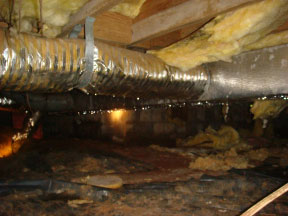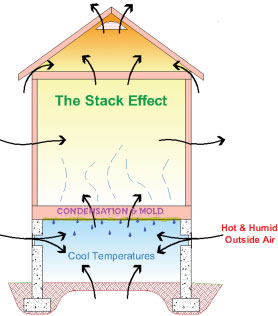


Naturally, poor exterior drainage conditions and/or plumbing leaks can lead to wetness in a crawl space under a house, but a lesser known problem is dampness caused by rising ground moisture and by humidity from foundation ventilation. Although building codes have required ventilation of crawl  spaces in the past, these requirements were not based on any scientific research. Building scientists have now proven that ventilation of crawl spaces can actually create more moisture than it removes, particularly in the southern region. This is because the air used to ventilate the crawl space is the exterior atmosphere and this air is very hot and humid more often than cool and dry. Therefore, ventilating crawl spaces in the south can introduce a large amount of moisture to a crawl space via humidity in the ventilation air. When this humid air enters a crawl space, it contacts cool surfaces such as the underside of the floor diaphragm, air-conditioning equipment, floor registers, or air ducts. Then, condensation forms on the cool surfaces, potentially creating all sorts of problems such as rot-related decay, mold/mildew growths, long-term deterioration of the air ducts, musty smells, moisture-damaged hardwood flooring, cracked ceramic floor tiles, and increased insect/vermin activity. Even worse, approximately 40 percent of the air in the living space originates from the crawl space due to the stack effect, creating unhealthy conditions inside the building.
spaces in the past, these requirements were not based on any scientific research. Building scientists have now proven that ventilation of crawl spaces can actually create more moisture than it removes, particularly in the southern region. This is because the air used to ventilate the crawl space is the exterior atmosphere and this air is very hot and humid more often than cool and dry. Therefore, ventilating crawl spaces in the south can introduce a large amount of moisture to a crawl space via humidity in the ventilation air. When this humid air enters a crawl space, it contacts cool surfaces such as the underside of the floor diaphragm, air-conditioning equipment, floor registers, or air ducts. Then, condensation forms on the cool surfaces, potentially creating all sorts of problems such as rot-related decay, mold/mildew growths, long-term deterioration of the air ducts, musty smells, moisture-damaged hardwood flooring, cracked ceramic floor tiles, and increased insect/vermin activity. Even worse, approximately 40 percent of the air in the living space originates from the crawl space due to the stack effect, creating unhealthy conditions inside the building.
A recent scientific study showed that the conditions in ventilated crawl spaces generally tracked the outside air conditions. Hence, when the outside air is very humid, the crawl air is also very humid. The relative humidity of the humid crawl-space air then increases when it comes into contact with colder surfaces such as the floors of air-conditioned homes, ducts or plumbing components, leading to condensation. However, when the crawl- space vents are sealed, the humidity levels in the crawl space remain fairly constant and reasonably low.
 The degree of problems from vented crawl spaces can vary widely from one building to another, but sealing existing vented crawl spaces will always lead to improvements by reducing the humidity levels. This reduces the likelihood of flooring damages and mold/mildew growths and vastly improves the indoor air quality. In addition, since it takes more energy to heat and cool moist air than dry air, a reduction in energy use of about 15 percent can be achieved by sealing crawl spaces. To do this, a heavy vapor retarder is placed over the entire ground surface and extended up onto the foundation walls to cover the vents. All seams and edges must be completely sealed. It may be necessary to replace deteriorated access doors, condition the crawl-space air, or to add a permanent dehumidifier. In areas with poor drainage conditions, a perimeter drain and sump pump may be necessary. Insulating the foundation walls or floors can help improve energy use but are not necessary to reduce moisture levels in most cases.
The degree of problems from vented crawl spaces can vary widely from one building to another, but sealing existing vented crawl spaces will always lead to improvements by reducing the humidity levels. This reduces the likelihood of flooring damages and mold/mildew growths and vastly improves the indoor air quality. In addition, since it takes more energy to heat and cool moist air than dry air, a reduction in energy use of about 15 percent can be achieved by sealing crawl spaces. To do this, a heavy vapor retarder is placed over the entire ground surface and extended up onto the foundation walls to cover the vents. All seams and edges must be completely sealed. It may be necessary to replace deteriorated access doors, condition the crawl-space air, or to add a permanent dehumidifier. In areas with poor drainage conditions, a perimeter drain and sump pump may be necessary. Insulating the foundation walls or floors can help improve energy use but are not necessary to reduce moisture levels in most cases.


